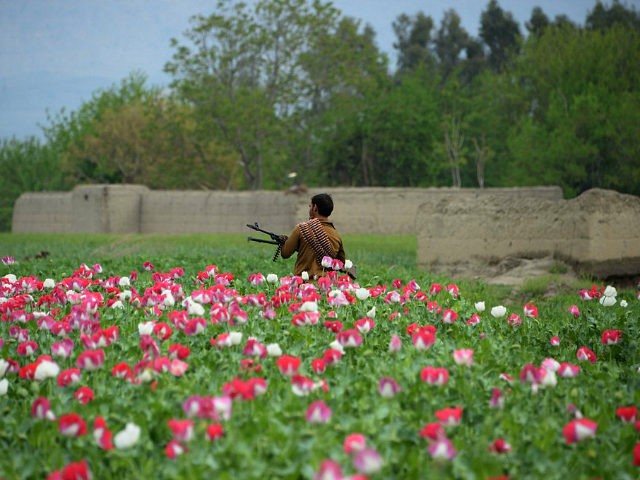The American government placed a revised version of the U.S. counternarcotics strategy in Afghanistan “on hold for more than two years” while cultivation and production of opium and its deadly heroin derivative has reached historic levels in the war-ravaged nation, reports a watchdog agency.
In its latest quarterly report to Congress, the Special Inspector General for Afghanistan Reconstruction (SIGAR) advises the GOP-led Congress and White House to implement a new counternarcotics strategy in Afghanistan, noting that the $8.5 billion U.S. effort to combat the opium and heroin trade has largely failed to prevent the country from continuing to be the world’s top producer of the illegal drugs.
“Despite a U.S. investment of $8.5 billion to counter Afghanistan’s illicit narcotics economy, the country remains the world’s largest opium producer and exporter—producing an estimated 80% of the world’s heroin,” notes John Sopko, the chief of SIGAR.
According to a list of suggestions for U.S. lawmakers and President Donald Trump’s administration found in the report, Inspector General (IG) Sopko advises:
Establish a counternarcotics strategy: A new U.S. government strategy to fight the narcotics trade in Afghanistan has been on hold for more than two years, and will need coordination with the host- country strategy approved by the Afghan parliament. Meanwhile, Afghanistan remains the world’s leading producer of opium, and Resolute Support and U.S. forces commander General John W. Nicholson Jr. estimates that the Taliban receive 60% of their funding from the opium trade.
Former President Barack Obama “postponed” approval of the strategy “until the new administration endorses the new strategy,” later adds Sopko.
The SIGAR report primarily covers the first quarter of the Trump administration — January 1 thru March 31.
Under Obama’s watch, eradication efforts dropped dramatically — by more than 90 percent in 2016.
Inspector General (IG) Sopko learned from the United Nations that “poppy eradication results in 2016 were the lowest this decade at 355 hectares [about 1 square mile]—a 91% decrease from 2015.”
The U.S. has only been able to interdict less than one percent of the opium that has been produced in Afghanistan since fiscal year 2008 (October 1, 2007, thru September 30, 2008), reports the IG, noting:
SIGAR has long tracked DOD [Department of Defense] and DEA reporting on the results of interdiction operations in Afghanistan… from 2008 through March 22, 2017, 3,371 interdiction operations have resulted in the seizure of 449,470 kg of opium.
However, this result was less than 1% of Afghanistan’s opium production. According to the December 2016 Opium Survey by the United Nations Office on Drugs and Crime (UNODC), Afghanistan’s potential opium production was approximately 4,800 metric tons (or 4.8 million kg) in 2016 alone.
The strongest and deadliest jihadist group in Afghanistan, the Taliban, is now able to generate most of its funding for terrorist activities from the illegal opium trade, Gen. John Nicholson, the top commander of American and NATO forces, told reporters last December.
Citing the Department of State’s Bureau of International Narcotics and Law Enforcement Affairs (INL), SIGAR explains:
[A] symbiotic relationship exists between the insurgency and narcotics trafficking. Traffickers provide weapons, funding, and material support to the insurgency in exchange for protection, while insurgent leaders traffic drugs to finance their operations. Production and trafficking of illicit narcotics flourish in areas where Afghan state institutions are weak, although trafficking is not limited to insurgent- controlled areas. The narcotics trade also undermines governance and rule of law throughout Afghanistan.
Some experts, including Ioannis Koskinas of the New America think-tank, have argued that the Islamic State (ISIS/ISIL) branch in Afghanistan, made up of disgruntled Afghan and Pakistani Taliban fighters, may also be involved in the opium trade.
The estimated production and cultivation area in Nangarhar province, considered ISIS’s primary stronghold in Afghanistan, has increased since the terrorist group established a presence there at the beginning of 2015.
SIGAR also points out that U.S. taxpayer-funded projects to improve irrigation for Afghan farmers have facilitated “more opium-poppy cultivation and boost revenues for insurgents.”
Rep. Dana Rohrabacher (R-CA) said last week that the United States government has been able to eradicate Afghanistan’s opium crops for more than 20 years but has refused to do so.
Referring to America’s refusal to destroy the opium poppies after the 9/11 attacks that prompted the U.S. to invade Afghanistan, the GOP congressman said, “The excuse was always ‘Oh we think they might be too close to a mosque.’”
While U.S. interdiction and eradication efforts have nearly disappeared, the opium poppy cultivation area and estimated production reached record levels in 2016 — 776 square miles and 4.8 million kilograms, respectively.
Cultivation area and estimated production has skyrocketed more than 25-fold since the U.S. invaded Afghanistan near the end of 2001.

COMMENTS
Please let us know if you're having issues with commenting.